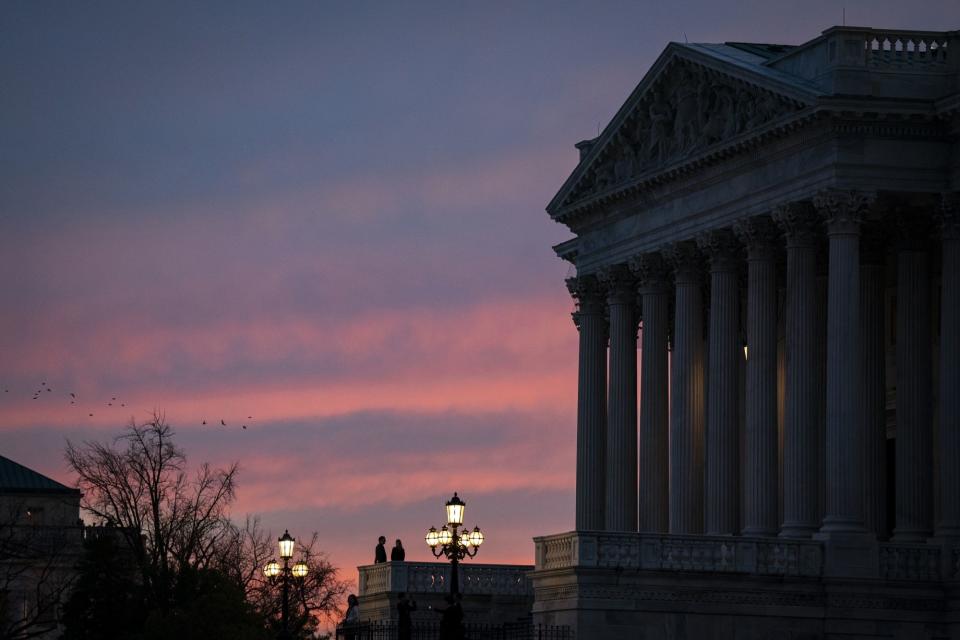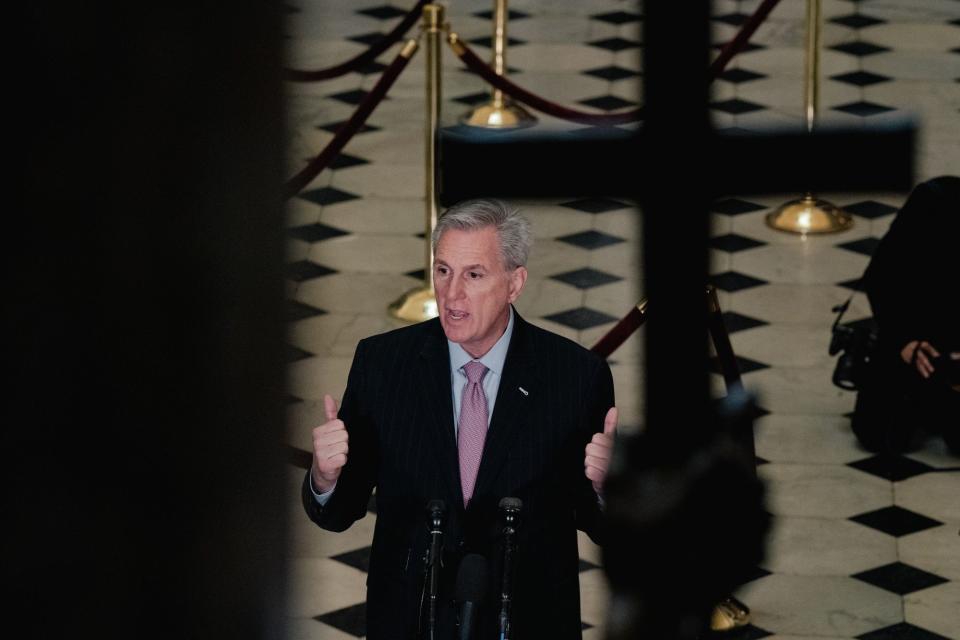‘Doomsday Clocks’ Likely Before Congress Hikes Debt Limit
- Oops!Something went wrong.Please try again later.
(Bloomberg) -- With the US government facing the danger of a payments default later this year, Congress has a variety of paths to avert economic disaster and boost the debt ceiling.
Most Read from Bloomberg
Pfizer Bivalent Vaccine Linked to Strokes in Preliminary Data
At Least 68 Dead as Nepal Plane Crashes Seconds Before Landing
This Isn’t Your Mom and Dad’s Recession, Says BofA’s Subramanian
Huge Sanctions Are Looming for the Fuel That Powers the World
All of them would likely involve going right up to the market-rattling brink, according to current and former lawmakers and aides.
The timeline kicked off Friday, when Treasury Secretary Janet Yellen advised congressional leaders the government will start deploying extraordinary accounting measures on Jan. 19 to avoid running out of cash. She said while it’s impossible to specify now when those measures will be exhausted, it’s unlikely to be before early June.
Republicans now in control of the House are demanding deep spending cuts as the price for an increase in the ceiling, while President Joe Biden and congressional Democrats reject such an outcome.
“I see movement there — but it’s not going to be without a lot of gnashing of teeth and doomsday clocks,” said Rodney Davis, a former Republican representative from Illinois.
The following are scenarios by which the debt ceiling could be handled this year:
Biden-GOP Talks
Ultra-conservatives in the House are banking on this option. As part of their deal to elect Kevin McCarthy as speaker, they won a concession that no debt limit increase would be approved without a budget agreement or “commensurate” fiscal reforms.
While the wording of the agreement offers some flexibility, conservatives want, at a minimum, $130 billion in cuts to discretionary spending in the fiscal year starting in October, and aim for a budget that balances in 10 years.
If McCarthy fails to get such an outline through the House, that would weaken his negotiating power with Biden. On the flipside, conservatives now have the power to trigger a vote on him remaining speaker, giving them leverage in talks.
McCarthy said Thursday he had already touched base with Biden. “I had a very good conversation with the president when he called me and I told him I’d like to sit down with him early and work through these challenges,” he told reporters.
Honoring the debt is “a sacred obligation,” and Congress will have to deal with it “without conditions, without games and without putting our economy at risk, ” White House economic adviser Brian Deese said on Bloomberg TV Friday.
2011 Scenario
The most harrowing debt-ceiling showdown in modern history came more than a decade ago, when S&P Global Ratings was alarmed enough to cut the sovereign US rating from AAA — which triggered ructions in markets, damaged consumer confidence and undermined the post-financial-crisis recovery.
President Barack Obama entered talks with House Republicans and ended up agreeing to both discretionary budget caps and a “super commitee” to look at reforms of entitlement programs.
Many economists now assess US fiscal policy as proving too tight in that period, restraining growth. Democrats have since adopted a harder position of refusing to negotiate, and there’s no sign of that changing now. Senate Democrats would reject a package balancing the budget in 10 years.
Still, a more flexible outline might not be impossible. Representative David Schweikert, an Arizona Republican, said he sees the impending showdown as an opportunity to come up with creative solutions on health care, such as spending more on telehealth to cut emergency-room visits.
One feature of the 2011 agreement gave the president the power to raise the debt ceiling, subject to congressional disapproval, a maneuver deployed in 2012.
House Democratic Push
House Democrats do have one mechanism to make an end-run around McCarthy and his caucus, called a discharge petition. If they convince six GOP representatives to join them, they could secure the 218 votes needed to force through a vote on some debt-limit bill they prefer.
But that’s technically difficult. The petition can only be made for a bill bottled up in a committee for more than 30 legislative days. That could be two to three calendar months, depending on congressional recesses. And there’s an additional floor delay of as long as nine legislative days.
It’s unclear whether enough GOP members would be open to crossing the aisle. Massachusetts Democrat Jim McGovern quipped, “The moderates are all afraid of their own shadow.”
Brian Fitzpatrick, a moderate Republican from Pennsylvania, called that strategy “an absolute last resort.”
“I don’t think we will need to. We have to maintain our full faith and credit and failure is not an option. I think there are enough people who are willing to extract themselves from a pure ideological position and have a compromise,” added Fitzpatrick, a leader of the bipartisan Problem Solvers Caucus.
Still, history shows the maneuver is possible. A discharge petition helped proponents reauthorize the Export-Import Bank in 2015, when conservatives tried to close it down.
This route would also need at least nine Republicans in the Senate to give the Democratic caucus in that chamber the 60 votes needed to defeat any filibuster.
The Senate Side
One scenario is for a “gang” of Senate Republicans to gather with Democrats to forge a compromise. One such gang produced the bipartisan infrastructure bill Biden signed into law in 2021. Fitzpatrick said he “100%” sees such a group as coming up with a viable compromise.
That would garner more support if backed by Senate Republican Leader Mitch McConnell. Back in 2011, following several rounds of talks between Obama and House Republicans, McConnell and Biden — then vice president — were called in to avert a default, recalled Rohit Kumar, who was a senior aide to McConnell during that crisis.
“I’m not sure he will be first at bat” addressing the debt limit now, Kumar said of McConnell.
Among potential gang leaders is West Virginia Senator Joe Manchin, who has said that any debt-ceiling increase should be paired with some measures to address the deficit. Manchin and Arizona Independent Kyrsten Sinema were among those unwilling to raise the debt ceiling with Democratic votes alone last year, when their caucus had the chance to use a special budget procedure to do it. They could come under pressure to broker a deal this year.
Utah Republican Mitt Romney has pitched a “Trust Act,” empowering so-called rescue committees to come up with solutions to shore up federal trust funds such as Social Security. The proposal of the committees would receive an up-or down vote. Variations of this idea including the Obama-era deficit commission have been tried in the past and could be tied to short-term debt-limit increases to enforce action.
McCarthy Folds
Faced with an imminent US default, McCarthy could simply put a debt ceiling increase on the House floor that falls short of the fiscal goals of conservatives, and risk their wrath.
Before that step, hard-line Republicans could offer a motion to oust McCarthy. At that point, it’s unclear how Democrats would vote, points out former top GOP aide Brendan Buck on Twitter.
If Democrats voted to save McCarthy, he would then be politically damaged in the eyes of his members. At the same time, many might consider him a hero for falling on his sword to save the economy.
Outlandish Options
Suggestions have been made in the past that the Treasury should simply ignore the statutory limit or come up with a creative solution to work around it. One is the idea of minting a trillion-dollar coin and depositing it in the Treasury’s general account at the Federal Reserve.
Yellen has repeatedly opposed that or other gimmicks. And she’s said it would politicize the Fed to ask it to print money to cover the debt.
The Treasury could also take the extreme step of simply ignoring the debt ceiling, and having the decision challenged in court. Such scenarios are unprecedented — but so is a non-technical US default on its debt.
Payment Default
Kumar, who’s now at PricewaterhouseCoopers LLP, said the prospect of the Treasury actually defaulting, while higher than usual is “still quite low.”
He added, however, that “more likely than not, greater than 50%, that we get within days of default.”
How a default would happen is unclear. Before failing to make payments on government bonds, the Treasury might fail to meet some other obligation such as federal benefit payments or a payment on a contract.
“I’m nervous about it,” said Maxine Waters of California, the top Democrat on the House Financial Services Committee. “We are losing our place in the world and I don’t want us to have this big nasty fight and I certainly don’t want to lose it.”
Mark Cabana, head of US interest rates strategy at Bank of America Corp., warned that the shock to markets would be so powerful the Fed would likely have to make vast emergency purchases of Treasury securities, as it did in the spring of 2020 to avoid a freezing up of credit. “It’s unfortunately a really plausible kind of outcome.”
Bill Hoagland, a former budget aide to Senate Republicans, said, “History would suggest this is going to go right up to the last minute, with all the drama that comes with it.”
--With assistance from Billy House and Alexandra Harris.
(Updates with Yellen’s timeline in third paragraph.)
Most Read from Bloomberg Businessweek
Airlines Resurrect Ancient Jumbo Jets to Meet First- and Business-Class Demand
Housing Pain to Continue Until Economy Slows and Prices Fall
Young Bankers Who Got Used to Smooth Sailing Prepare for a Storm
©2023 Bloomberg L.P.




